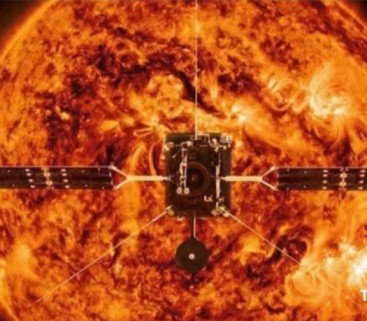Aditya-L1 Mission is India’s mission to study the Sun from a spot 1.5 million km away at Lagrange Point 1 (L1). It has seven tools to explore different parts of the Sun using detectors for things like electromagnetic, particles, and magnetic fields. Aditya L1 wants to learn about things like why the Sun’s outer layer gets hot, sudden bursts of energy, and space weather changes. Its special orbit gives us non-stop views, changing the way we study the Sun and helping us learn more about its complexities and how it affects space weather. Four tools watch the Sun directly, and three study things around Lagrange Point L1. This helps us understand how the Sun’s actions affect the space between planets.
Aditya-L1 Mission Milestones:
Launch and Early Maneuvers:
On September 2, 2023, the successful launch of India’s first solar observatory, Aditya-L1, by PSLV-C57 marked the commencement of its journey towards the Sun-Earth Lagrange Point 1 (L1). The satellite, placed precisely into its intended orbit, has been operating nominally, with the first Earth-bound maneuver (EBN#1) successfully executed, achieving a new orbit of 245 km x 22,459 km. Subsequent maneuvers, including EBN#2 on September 3, EBN#3 on September 5, and EBN#4 on September 10, were also performed successfully, progressively adjusting the satellite’s trajectory.
Initiation of Scientific Data Collection:
On September 15, 2023, Aditya-L1 initiated the collection of scientific data, signaling the beginning of its mission. As the spacecraft continued its journey, an assessment of the space situation around Sun-Earth Lagrange Point L1 was conducted on September 19, 2023.
Trajectory Correction Maneuver (TCM):
A Trajectory Correction Maneuver (TCM) was executed on October 6, 2023, following the Trans-Lagrangean Point 1 Insertion (TL1I) maneuver performed on 19, September. Making sure the spacecraft stayed on its planned route for insertion into the Halo orbit around Lagrange Point 1 (L1).
Operationalization of Instruments:
Important moments in the mission include making the Solar wind Ion Spectrometer (SWIS) in the Aditya Solar wind Particle Experiment (ASPEX) payload operational on November 7, 2023. Also, capturing the first High-Energy X-ray view of Solar Flares happened on October 8, 2023, with HEL1OS.
High-Energy X-ray Glimpse:
The spacecraft’s successful escape from Earth’s influence on September 25, 2023, was followed by in-orbit health assessments of scientific instruments, including the Plasma Analyser Package for Aditya (PAPA) on December 1, 2023.
Halo Orbit Insertion:
The successful insertion of Aditya-L1 into a Halo-Orbit around Sun-Earth L1 on December 8, 2023.
As of January 6, 2024, the Aditya-L1 solar observatory continues its mission, capturing full-disk images of the Sun in near ultraviolet wavelengths with the SUIT payload and providing valuable insights into solar activities from its strategic vantage point.
Inaugural Solar Exploration: Aditya L1 Mission
ISRO’s pioneering space mission, Aditya L1, marks the nation’s inaugural endeavor solely dedicated to the in-depth study of the Sun. Positioned strategically in a halo orbit around Lagrange Point 1 (L1) of the Sun-Earth system, approximately 1.5 million km away from Earth, this mission provides a unique vantage point for uninterrupted solar observations, free from occultation or eclipses.
Real-Time Solar Monitoring:
The distinctive location at Aditya-L1 enables real-time monitoring of solar activities, offering valuable insights into the dynamic nature of the Sun and its influence on space weather.
Aditya-L1’s mission revolves around key scientific goals, focusing on unraveling the mysteries of the Sun’s upper atmosphere. Here’s a breakdown of its objectives in simpler terms:
- Understanding Solar Dynamics: Investigate the behavior of the Sun’s upper atmosphere, specifically the chromosphere and corona.
- Unraveling Solar Mysteries: Explore the heating processes of the chromosphere and corona, the physics of partially ionized plasma, and the triggers behind coronal mass ejections (CMEs) and solar flares.
- Observing Particle Environment: Gather data on particles and plasma surrounding the Sun, contributing to the study of their dynamic behavior originating from the solar surface.
- Deciphering Solar Corona: Delve into the physics of the solar corona and uncover the mechanisms responsible for its heating.
- Plasma Diagnostics: Use instruments to diagnose the properties of plasma in the coronal loops, such as temperature, velocity, and density.
- CME Development: Investigate the development, dynamics, and origins of coronal mass ejections (CMEs), pivotal events in solar activity.
- Understanding Solar Eruptions: Identify the sequence of processes occurring at different layers (chromosphere, corona base, and extended corona) leading to solar eruptive events.
- Mapping Magnetic Fields: Explore the topology of magnetic fields and measure their strength in the solar corona, providing insights into the Sun’s magnetic influence.
- Space Weather Drivers: Uncover the origins, composition, and dynamics of solar wind, which serves as a driver for space weather phenomena affecting our solar system.
In essence, Aditya-L1 aims to demystify various aspects of the Sun’s behavior, from its dynamic atmospheric layers to the triggers behind solar eruptions, ultimately contributing to our understanding of space weather and its impact on our technological infrastructure. 
Operationalization of Instruments:
Equipped with seven payloads, Aditya L1 aims to explore the photosphere, chromosphere, and the outermost layers of the Sun, known as the corona. The spacecraft carries electromagnetic, particle, and magnetic field detectors to facilitate comprehensive observations.
1. Aditya L1 Mission Overview:
- Objective: Explore the photosphere, chromosphere, and corona of the Sun.
- Payloads: Seven instruments for comprehensive observations.
2. Payload Categories:
- Electromagnetic, Particle, and Magnetic Field Detectors: Facilitating diverse data collection.
- Observation Focus: Four payloads directly observe the Sun; three conduct in-situ studies at Lagrange Point L1.
3. Dual Approach for Scientific Investigations:
- Solar Dynamics: Studying propagatory effects in the interplanetary medium.
- Lagrange Point L1: In-situ studies of particles and fields.
4. Significance of Aditya L1 Payloads:
- Coronal Heating: Unraveling the complexities.
- Coronal Mass Ejections: Comprehensive study.
- Pre-flare and Flare Activities: Observing solar phenomena.
- Space Weather Dynamics: Analyzing solar-terrestrial environment interactions.
5. Solar Phenomena Exploration:
- Data Collection: Valuable insights into coronal heating, CMEs, flare activities, space weather dynamics.
- Propagation Studies: Investigating particle and field propagation.
6. Contribution to Scientific Understanding:
- Advancing Knowledge: Enhancing comprehension of solar processes.
- Solar-Terrestrial Environment: Understanding the broader influence.
7. Expected Data Impact:
- Scientific Advancements: Significant contributions to solar science.
- Broader Implications: Informing our understanding of solar-terrestrial dynamics.
Aditya-L1 Solar Mission Timeline Download
The Future of the Mission Aditya L1:
The Aditya L1 mission has successfully completed the crucial Halo Orbit Insertion phase, marking a significant milestone. Now, the spacecraft is transitioning from the cruise phase to the orbit phase. During this transition, Aditya L1 will commence its scientific observations of the Sun, aiming to uncover various phenomena originating from our star.
The head of the Indian Institute of Astrophysics, Annapurni Subramaniam, said that putting the spacecraft into the Halo Orbit is crucial. She emphasized that it opens the door for the spacecraft to start doing its scientific work. This phase marks a pivotal moment in the Aditya-L1 Mission journey, and the team eagerly anticipates the commencement of instrument operations to delve into the study of the Sun and its diverse activities.
ISRO Chairman S Somanath says:
On ISRO’s Solar Mission Aditya-L1 entering Halo Orbit, ISRO Chairman S Somanath says “Today’s event was only placing the Aditya-L1 in the precise Halo orbit. So it was moving towards a high orbit, but we had to do a little bit of corrections… So right now, in our calculation, it is at the right place. But we are going to monitor it for the next few hours to see whether it is at the right place. Then if it is slightly drifted, we may have to do a little bit of correction.
We don’t expect that to happen… Images have been already put out on the website. We also have particle measurements, what is coming out of the sun… Then we also have x-ray measurements, which are in low energy and high energy x-ray measurements. We also have a magnetometer, which looks at the space magnetism field, which is coming because of these ejections. The solar wind is essentially the particle emission which is happening… A lot of people are interested in understanding this effect. So we look forward to a lot of scientific outcomes in the coming days. At least five years of life is guaranteed with the fuel left out in the satellite…”
conclusion:
Aditya L1, India’s pioneering solar mission, has made impressive strides in uncovering the Sun’s secrets. By carefully navigating its path and taking unique pictures of solar flares, the mission showcases India’s excellence in space exploration. As Aditya L1 continues its journey, scientists worldwide are excited about the valuable information and important discoveries it’s expected to revea
FAQs
- When was Aditya L1 launched?
- Aditya L1 was successfully launched on September 2 last year.
- What is the primary objective of Aditya L1?
- The mission aims to observe the Sun’s corona from a halo orbit around the first Sun-Earth Lagrangian point (L1).
- How many maneuvers has Aditya L1 undergone?
- Aditya L1 has undergone four earth-bound maneuvers and a Trans-Lagrangean Point 1 Insertion (TL1I) maneuver.
- What is the significance of the Lagrange Point in the mission?
- The Lagrange Point provides gravitational equilibrium, offering a stable position for observational purposes.
- When is Aditya L1 expected to reach its final destination?
- Aditya L1 is scheduled to reach its L1 point on January 6 at 4 pm.
